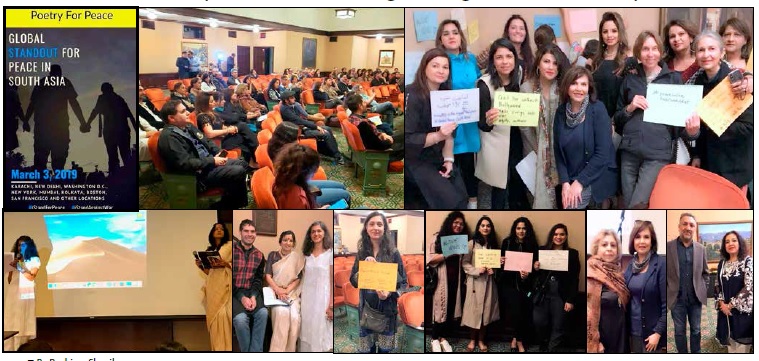Solidarity, Peace and Dialog through Art and Poetry
By Raahima Shoaib
Photos by Yasmin Javed

As the tensions between Pakistan and India remain a reality and Kashmir lingers on as an unresolved issue, there is some comfort to be sought in the solidarity and call for peace that is being expressed around the world. Pakistanis and Indians around the globe are coming together to condemn the call to violence and are calling for a peaceful and diplomatic solution to the occupation in Kashmir.
On Sunday, March 3rd, more than 20 communities in cities around the globe stood together in solidarity for peace in South Asia as a response to the escalation of violence between Pakistan and India over the issue of Kashmir. In Los Angeles, Poetry for Peace, was an artistic response to “Global Standout for Peace in South Asia,” and the event materialized in just three days with the help of a WhatsApp group chat that comprised of many board members from the Pakistan Arts Council and community activists.
The event sponsored by Mohubbat, an LA-based organization founded by Azhar Hameed, works to bring together Pakistanis and Indians globally. Their mission statement is to “build an exemplary global community of Indians and Pakistanis around the world who not only promote local inter-community integration and development but also support initiatives of peace and prosperity around the world”.
Sehba Sarwar, poet and artist, who also serves on the Pakistan Arts Council (PAC) Board, conceived the gathering. She was inspired by her sister, journalist Beena Sarwar, who is one of the leaders of the global movement. Most of the responses in cities including Karachi, Mumbai, Kolkata, Washington DC were political rallies, but Sehba brought an artistic twist to Global Standout. In collaboration with fellow PAC board members Naila Ahmed (PAC President), Ayesha Kamran, and Farah Bhatti, they were able to arrange the use of the Pasadena Central Library auditorium on the same day as the Global Standout for Peace for Poetry for Peace.
In an interview, Sehba said: “I am an artist, and that’s how I respond to moments like this…” As such, Poetry for Peace manifested in the form of an open mic with poetic responses to the violence. At such short notice, Sehba, Ayesha, and the organizing team couldn’t pin down a large group of poets to perform. Instead, community members were invited to bring their own poems (if they had any), or read work by artists they admire. With representatives from all over South Asia - and the world- present and performing, this event truly was the most appropriate response to everything that’s taking place between Pakistan and India
Before the open-mic started, co-hosts Sehba and Diya Bose reminded everyone that “there cannot be peace without justice and an end to the occupation.” This set the tone for an afternoon full of poetic expression that crossed borders and identities and reached into the hearts of everyone attending. Diya read a poem by Agha Shahid Ali and the lineup included featured artists Anita Vora, Faryal Ahsan, Vivek Mittal, and Parveen Qazi. Attendees and open mic readers were from all around Southern California, some as young as 10 years old. Many original poems were read, but participants also shared poems in Urdu, English, and Hindi by well-known writers. Journalist Sara Sikandar created a collage of peace videos from India and Pakistan that volunteer Afreen Mirza helped her find.
In my perspective, Poetry for Peace, and the other gatherings that took place in more than 20 cities around the world, was crucial. The afternoon wasn’t necessarily about the poetry, the people, or even the crisis itself to which we were responding. Crises happen almost daily worldwide, and solidarity events and marches often follow. So I wondered why did Poetry for Peace feel so special? Why did it feel so different?
The only answer I could find was that the afternoon showcased the true meaning of being intersectional. Everyone in attendance connected through art and expression that united us. That is what was the most important takeaway. But how can we make sure that the sentiment in the room feeling extended beyond just the 70 people in that room? Shruti Bala Purkayastha, artist and collective member of LA Solidarity Summer Institute (LASSI) told me, “It is important to have spaces we can bridge our lives with the homelands that we are from, where our ancestors are from. There is much healing generationally for us to do together.” Sehba had a similar perspective, “We need to make a conscious effort to befriend people from across the border...and to break past the trend that there is very little mixing amongst the immigrant generation.” By getting to know someone from a different background, we can each take one small step towards peace.
Regardless of what our background is, where we have come from or which religion we follow, we can make an impact by taking steps to create spaces for dialogue or acknowledge the rise of fundamentalism on either sides of the border. We have a personal responsibility to make sure that we, as individuals, are not part of the problem but rather part of the solution.
-----------------------------------------------------------------------------

